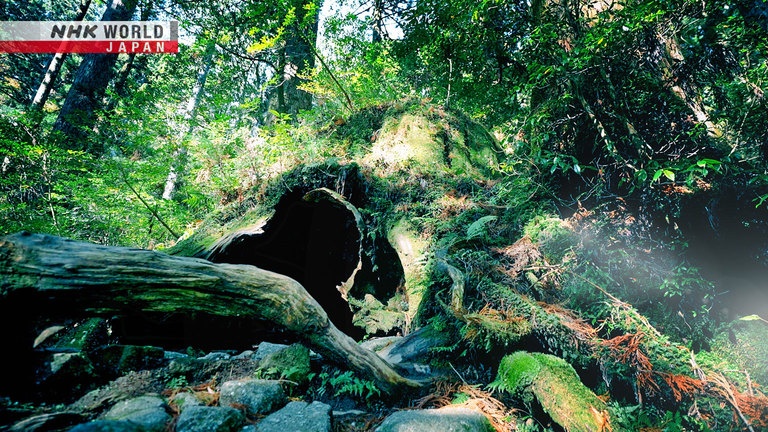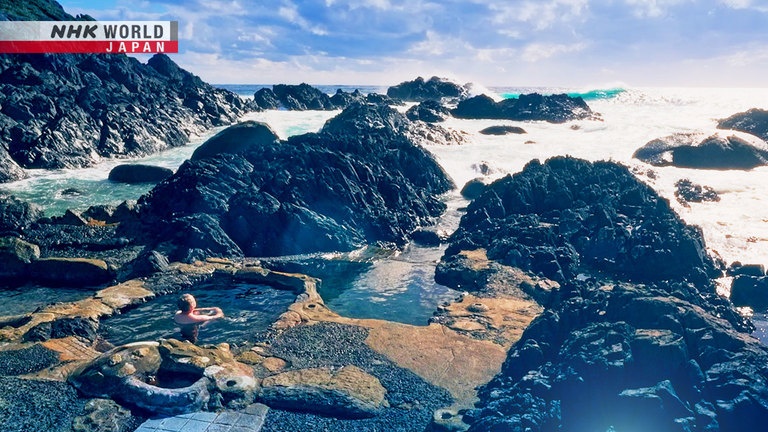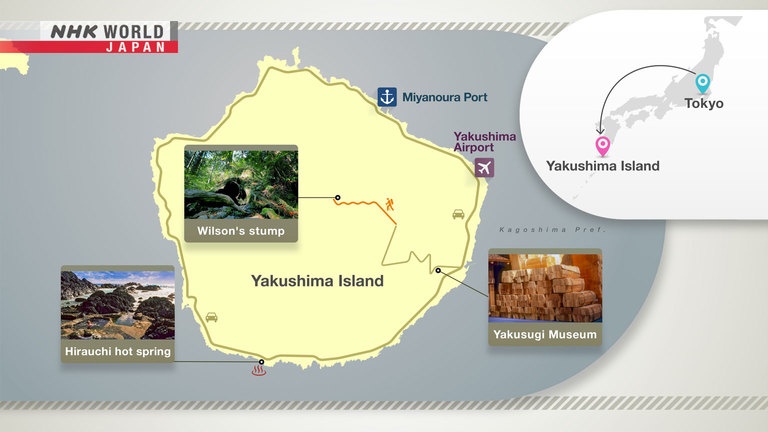Yakushima Awakenings
Yakushima, off Kagoshima Prefecture in Kyushu, is a magical island of primeval forest, rare micro-climate and pristine nature. It is also the first place in Japan to be recognized as a UNESCO World Natural Heritage Site. British plant-hunter, Ernest Henry Wilson, explored Yakushima in the early 20th century, researching and photographing its ancient Yakusugi trees. Photographer Alfie Goodrich travels to the island and becomes a conduit for the famous plant-hunter Wilson...
Wilson's Stump

This enormous stump is from a Yakusugi dating back around 2,000 years. It is named for the British plant-hunter, Ernest Wilson, who introduced it to the world in 1914 in words and images.
Hirauchi Kaichu Onsen (Undersea Hot Spring)

This hot spring gushes up from under the sea. Visitors can take a bath only during low tide, which happens 2 times a day.
Yakusugi Museum

Visitors can learn all about the magnificent Yakusugi with dioramas and CG imagery. Other Yakushima botanical life is also introduced.
Access

To reach Yakushima from Tokyo, it's about 2 hours by air to Kagoshima. From there it's a 30-minute flight. You can also go by boat.
Transcript
"Journeys in Japan"
Time passes quietly...
for thousands and thousands of years.
A centenary ago, a visitor steps foot into this fairy tale island.
His camera captures Yakushima's precious chords of time.
And remembers the forest.
With memories passed down through the people.
A continuum.
On "Journeys in Japan," we venture 100 years into the past
to trace the mind of a plant hunter,
to see what that holds for the future.
Yakushima Awakenings
One thousand kilometers and a world away lies Yakushima,
off Kagoshima in Kyushu.
In 1993, it was designated a UNESCO World Natural Heritage Site.
Mountains shoot nearly 2,000 meters above sea level.
Precious nature, virgin forest, largely remain untouched.
Deep into Yakushima.
There is an awakening.
(100 years ago, you worried about this island's fate.)
(Allow me to grant you your wish.)
Thank you.
By a slip of fate, the visitor has been transported into the future.
Meet Ernest Henry Wilson,
the celebrated British explorer and plant collector.
Ah yes, this is the stump that I found.
He photographed this 100 years ago.
The Wilson's stump.
It's a massive four meters tall with a circumference of 13.8 meters.
(Wilson's stump)
Oh, what a wonderful surprise. They've named this after me.
Photographer Alfie Goodrich acts as a conduit
to bring Wilson into the present.
And who could be more fitting, as they're distant relatives.
An author in Yakushima has written a biography of Wilson.
Furui Tomoko.
In 1914, Wilson came to Japan on behalf of Harvard University.
He visited Yakushima, stayed for nine days, and took 58 photos.
While searching for rare plants, he also documented his subjects.
Wilson's images not only captured the plants,
but also the surrounding landscape that nurtured them.
That's why we can understand the environment of 100 years ago.
He was captivated by the rare nature.
He enthusiastically recommended preserving this ecosystem
to his traveling companions and research colleagues.
Yakushima later became a national park.
And the path was paved for becoming a World Natural Heritage Site.
How has the island changed?
Nice to meet you.
You must be Mr. Wilson. I've been expecting you. I will guide you around.
Matsumoto Kaoru is the director of the Yakusugi Museum.
Mr. Wilson, do you know what this tree is?
Sugi, Japanese cryptomeria?
Sugi over 1,000 years are called "Yakusugi,"
and those younger, "Kosugi." We differentiate them.
This one is magnificent. We believe it is over 1,000 years old.
It deserves to be called Yakusugi.
Sugi is an endemic species of Japan,
growing in areas from southern Hokkaido to the southernmost Yakushima.
Yakushima's sugi are enormous.
Generally, sugi grow quickly.
But Yakushima is formed of granite. Yakusugi are rooted in its thin soil.
So, they grow where nutrients are very scarce. That's Yakusugi.
But water is abundant. By taking in that water, the trees grow slowly.
And so, the annual rings are spaced closer together.
That means the trunks are less likely to decay, extending tree life.
As a result, they become huge.
Even when the trunks are of the same radius,
the annual rings are closer together in Yakusugi.
In the Edo period, Yakusugi were plundered in logging.
Islanders used the lumber to pay their taxes.
Highly durable, Yakusugi was in demand nationally as a material for shingles.
The felling of these trees continued until 1981.
So, does that mean there are no Yakusugi forests anywhere else but here?
Yes. And no one can cut down Yakusugi here.
This area is fully protected.
Properly separated from man-made forests, they are firmly protected.
In Wilson's image from 100 years ago...
the impact of logging is visible.
And now...
Where the mountain was scarred 100 years ago,
trees have returned thanks to conservation efforts
that included replanting campaigns.
Whether it be now or 100 years ago,
sitting here deep in the forest, surrounded by nature,
it's an important reminder we should take care of our environment.
Excuse me, sir. What are you looking at?
I was looking at "domaiboku."
Kashima Yuji is a woodworker.
What is that?
Fallen Yakusugi from the Edo period.
Fallen Yakusugi carpeted by moss, are seen everywhere.
Woodworkers treasured these stumps and fallen trees
called domaiboku as a resource.
But now, even domaiboku is protected.
This is my studio.
And a splendid one it is.
This is a 1,000-year-old Yakusugi.
Oh, really? Goodness me.
When I was here 100 years ago,
I never saw anybody making anything like this from Yakusugi.
Splendid.
Kashima still has pre-banned domaiboku,
which he uses sparingly and treats with the utmost care.
He had actually started out doing domaiboku removal work,
but after a serious injury on the job, he turned to woodworking.
I just couldn't distance myself from Yakusugi.
Kashima's relation to Yakusugi has only deepened.
This is a selection of my Yakusugi collection.
Please look at this color, gloss, and the gorgeous grain.
Even unworked, it's a piece of art.
That's right. Yakusugi is extraordinary by simply being.
For you, Yakusugi is a treasure.
Over thousands of years, Yakusugi develop into such exquisite forms.
I love the nature of Yakushima.
I understand completely.
Ah, hot spring.
(Hirauchi Kaichu hot spring)
Most of the time, the hot spring is submerged,
but around low tide, a window opens up for dipping.
Four hundred years ago,
locals chiseled out these natural baths for restoring their health.
And this tradition continues.
I can feel 100 years of fatigue just washing away.
Mr. Wilson, sorry to have kept you waiting. Your room is ready.
Thank you.
Wilson could not fathom how much had changed at the hotel since his last stay.
This is our suite.
Wow. Magnificent.
Well, I really shouldn't sleep.
It'd be such a waste of time. There's so much to do here.
Oh, I'm still in the future.
Morning.
What's this? What are you doing?
This is an underwater camera. I dive into the sea and take photographs.
Takaku Itaru works professionally as an underwater photographer.
Come to think of it, I was so interested in Yakusugi,
I never paid much attention to the ocean in Yakushima.
Yakushima's gorgeous ocean is often overshadowed by its forests,
yet it is teeming with marine life, vast coral reefs,
and rare small creatures.
A marvel.
Takaku also creates conceptual pieces.
In his series, "Environment,"
colorful fish cluster around a large net.
Two peer out from a can.
His work takes up pollution.
I feel how the impact of human actions and global warming is playing out.
Garbage washes up on coast, and plastic waste floats in the sea.
I am shaken by how fast global warming is accelerating.
By photographing the ocean around Yakushima,
I hope to spread awareness about this reality.
The ecosystem of the ocean is out of balance.
Excuse me, what are you doing?
I am cutting back undergrowth so people can enter.
Imamura Yuki runs an ecotour company.
He also works in forest preservation.
When people visit the forest and thin it regularly, light enters.
When light floods in, the roots of diverse plants grow deep into the ground.
And that protects the soil.
Mountains are linked to the ocean by rivers and groundwater paths.
And they carry nutrients, which enrich the sea.
This is why forests must be maintained.
Right. So, it's not just about planting these artificial forests,
but about humans continuing to intervene to maintain them.
Is this citrus fruit?
The green ones are "Tankan" and beyond them are "Ponkan."
They are both Yakushima specialties.
We come down the mountain to the village.
We live here, blessed by the fruits and vegetables we grow.
That sounds like a wonderful way to live.
Please watch your step.
Okay.
Mr. Wilson, I'll show you something interesting.
What's this?
Spring water is jetting out from under this rock.
Minerals from the mountain and from the sea merge, and spring out.
Well, it's not as hot as where I took a bath.
Would you like to taste it?
Slightly salty, almost tastes like a soup stock.
I believe this cycle of water supports Yakushima's forests and sea.
Let's make salt from this spring water and use it for cooking.
Hello.
This is my friend, Ono-san.
Pleasure to meet you.
Nice to meet you.
I will head off to prepare our dinner.
From here, Ono-san will show you round.
They head to lodgings run by Ono, Imamura and others.
Architect Ono Tsukasa designed this compound.
It's like the nature and the building are one.
I designed this building with the concept of not interfering with nature's cycle.
There are two reasons behind this elevation.
One is to avoid obstructing the natural flow of air and water.
The other is to adapt with the surrounding plants.
The raised foundation, without a concrete surface means...
rain can reach tree roots.
Columns linking to surrounding trees, also strengthens the ground.
In 2023, the architecture was recognized
with an international award for sustainable housing.
Mr. Wilson, of course, we used local sugi.
Electricity is generated by rooftop solar panels,
and stored in batteries under the floor.
People are connected to nature. This is vital to our concept.
Since my time,
I can see that respect for the environment has dramatically improved.
The meal is ready.
Today's menu includes local seasonal fish.
And pickled locally-harvested vegetables.
This rice is steamed with the spring water we collected at the beach.
Please, enjoy.
That salt is extraordinary.
With the fish, it's the perfect accompaniment.
It's good.
Fantastic.
Yakushima is really abundant.
Yes, that's right. From ancient times, people here would say,
"Ten days in the mountains, ten days at sea, ten days in the field."
They lived with harvests from their fields, the mountains, and the ocean.
I believe if people were awakened to our connection with this great nature,
we would take better care of it.
I can feel all the way through my body.
Wilson's journey, past and present, is winding down...
But before so...
Mrs. Furui.
Nice to meet you, Mr. Wilson. Please come in.
Have a seat.
Thank you very much.
Compared to 100 years ago, how did you find Yakushima now?
Of course it's changed, and maybe it's even better.
Yakusugi, trees over 1,000 years old,
seem to be decreasing in number.
People recognize its value.
It's been well managed.
Moreover, not only Yakushima island,
but also the sea around it.
I thought it was wonderful people were paying attention to that too.
The importance of the cycle of mountain, village, and sea.
A way of living in balance that I learned in Yakushima.
There's something I took to heart, and that perhaps we all should.
I came to Yakushima just over 100 years ago
and photographed this stump,
a picture which has contributed over the years
to an increased awareness of protecting the environment here.
Something which as a plant hunter, I'm incredibly proud of.
I should be back here in 100 years to check on Yakushima's progress.
"When you destroy the forests you upset the balance of nature."
"The present generation must remember that"
"it only holds the forests in trust for future generations."
(ERNEST HENRY WILSON)
To reach Yakushima from Tokyo,
it takes about two hours by plane to Kagoshima.
From there, it's 30 minutes by air.
Or you can catch a ferry.